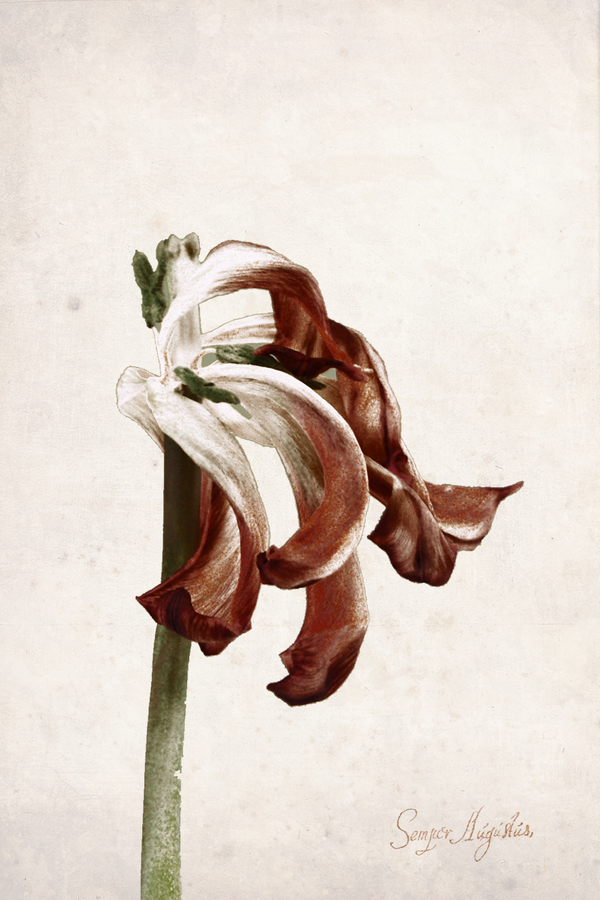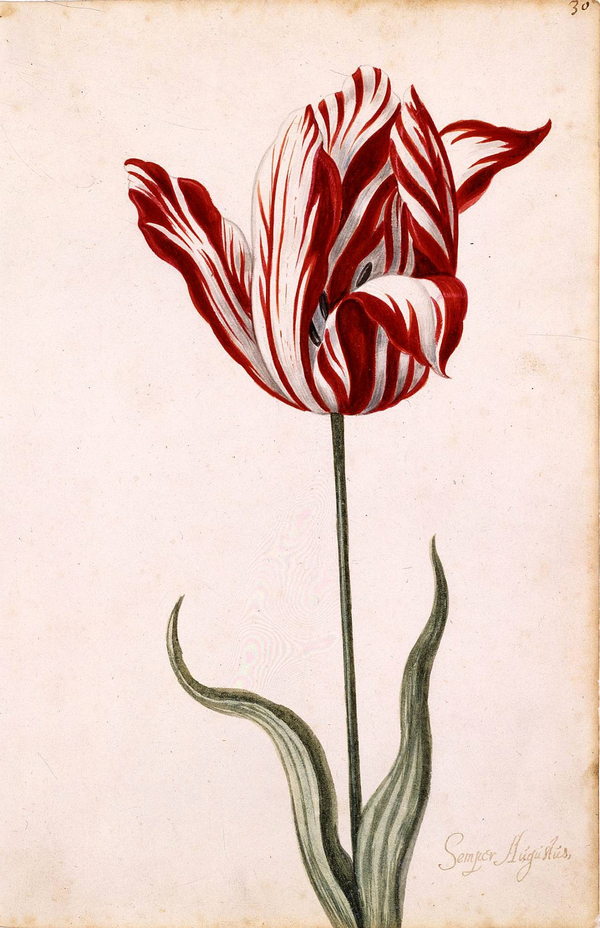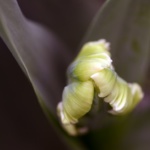.
Forgery
Amused myself by doing a forgery just now. On the right is Semper Augustus, an anonymous 17th-century watercolor of the tulip famous for being the most expensive one sold during tulip mania. On the left is my version of it.Tulip mania, unlike mortgage mania, has the advantage of being about something pretty. And a national industry grew up around tulips in the end. Can’t see mortgages or bonds go on picture postcards …
Wahid Saleh: Unbelievable though it may seem, somewhere near the early 17th century a single bulb of high quality would fetch several thousand florins. It was quite extraordinary. By 1624 things had progressed to such a craze that one tulip, the famous white and maroon “Rembrandt-type” tulip ‘Semper Augustus‘, could command a price as high as 3,000 florin per bulb. And there were only 12 bulbs available for sale. Just a short time later, a similar bulb fetched 4,500 florin, plus a horse and carriage. To give an idea of what 3,000 florins could buy at the time: two loads of wheat, four loads of rye, four fat oxen, five swine, 12 sheep, two hogsheads of wine, four barrels of beer, two barrels of butter, a thousand pounds of cheese, one complete bed, one suit of clothes, one silver tankard and a sizeable wagon to haul it all away.
One would suppose that there must have been some great virtue in this flower to make it so valuable in the eyes of so practical a people as the Dutch; but in fact it was just the greed of making a fast buck. The tulip bulbs seduced the Dutch elite. There are many surviving receipts and contracts from that period showing that people traded large houses, businesses, ships, and farms for a single tulip bulb. People also borrowed huge sums of money, regardless of the terms of the loan or the interest rate, to speculate at the tulip market.
Wiki: The tulip was different from every other flower known to Europe at that time, with a saturated, intense petal color that no other plant exhibited. The appearance of the non pareil tulip as a status symbol at this time coincides with the rise of the newly independent country’s trade fortunes. No longer the Spanish Netherlands, its economic resources could now be channeled into commerce and the country embarked on its Golden Age. Amsterdam merchants were at the center of the lucrative East Indies trade, where a single voyage could yield profits of 400%.[16] The new merchant class displayed and validated its success, primarily by erecting grand estates surrounded by flower gardens, and the plant that had pride of place was the sensational tulip.
As a result, the flower rapidly became a coveted luxury item, and a profusion of varieties followed. They were classified in groups: the single-hued tulips of red, yellow, or white were known as Couleren; the multicolored Rosen (white streaks on a red or pink streaks background), Violetten (white streaks on a purple or lilac background), and the rarest of all, the Bizarden (Bizarres), (yellow or white streaks on a red, brown or purple background.[17] The multicolor effects of intricate lines and flame-like streaks on the petals were vivid and spectacular and made the bulbs that produced these even more exotic-looking plants highly sought-after. It is now known that this effect is due to the bulbs being infected with a type of tulip-specific mosaic virus, known as the “Tulip breaking virus”, so called because it “breaks” the plant’s lock on a single color of petal.[18][19]
The tulip was itself a conspirator in the supply-squeeze that fueled the speculation, in that it is grown from a bulb that cannot be produced quickly. Normally it takes 7–12 years to grow a flowering bulb from seed; and while bulbs can produce both seeds and two or three bud clones, or offsets annually, the “mother bulb” lasts only a few years. Properly cultivated, the “daughter offsets” will become flowering bulbs of their own after one to three years. Prior to the demand for the “broken” tulips, virus-free bulbs producing ordinary single-color varieties were sold by the pound. Once affected by the virus, the “broken” exotics were an extremely limited commodity because the sought-after “breaking pattern” can only be obtained through offsets, not seeds, as it is only the bulb that is affected by the mosaic virus. Unfortunately, the virus that produced the sought-after effects also acted adversely on the bulb, weakening it and retarding propagation of offsets, so the cultivation of the most appealing varieties now took even longer. Taking this into account, it is quite probable that from the time the speculation started until its collapse, the actual number of rare bulbs that changed hands so feverishly never increased beyond the original number.
The beautiful effects of the virus made the flamboyant and extravagant plants highly coveted, and because they were rare and desirable, they were expensive. Given that, it is not surprising growers named their new varieties with exalted titles. Many early forms were prefixed Admirael (“admiral”), often combined with the growers’ names: Admirael van der Eijck for example, was perhaps the most highly regarded of about fifty so named. Generael (“general”) was another prefix that found its way into the names of around thirty varieties. Later varieties were given even more superb and high-flown names, derived from Alexander the Great or Scipio, or even “Admiral of Admirals” and “General of Generals”. However, naming could be haphazard and varieties highly variable in quality.[20] Most of these varieties have now died out,[21] though virus-free variegated-bred tulips continue in the trade.
Tulips bloom in April and May for only about a week. During the plant’s dormant phase from June to September, bulbs can be uprooted and moved about, so actual purchases (in the spot market) occurred during these months.[22] During the rest of the year, florists, or tulip traders, signed contracts before a notary to purchase tulips at the end of the season (effectively futures contracts).[22] Thus the Dutch, who developed many of the techniques of modern finance, created a market for durable tulip bulbs.[12] Short selling was banned by an edict of 1610, which was reiterated or strengthened in 1621 and 1630, and again in 1636. Short sellers were not prosecuted under these edicts, but their contracts were deemed unenforceable.[23]
As the flowers grew in popularity, professional growers paid higher and higher prices for bulbs with the virus, and prices rose steadily. By 1634, in part as a result of demand from the French, speculators began to enter the market.[25] The contract price of rare bulbs continued to rise throughout 1636, but by November, the price of common, “unbroken” bulbs also began to increase, so that soon any tulip bulb could soon fetch hundreds of guilders. That year the Dutch created a type of formal futures markets where contracts to buy bulbs at the end of the season were bought and sold. Traders met in “colleges” at taverns and buyers were required to pay a 2.5% “wine money” fee, up to a maximum of three guilders per trade. Neither party paid an initial margin nor a mark-to-market margin, and all contracts were with the individual counter-parties rather than with the Exchange. The Dutch derogatorily described tulip contract trading as windhandel (literally “wind trade”), because no bulbs were actually changing hands. The entire business was accomplished on the margins of Dutch economic life, not in the Exchange itself.[26]
By 1636 the tulip bulb became the fourth leading export product of the Netherlands—after gin, herring and cheese. The price of tulips skyrocketed because of speculation in tulip futures among people who never saw the bulbs. Many men made and lost fortunes overnight.[27]
Tulip mania reached its peak during the winter of 1636–37, when some bulbs were reportedly changing hands ten times in a day. No deliveries were ever made to fulfill any of these contracts because in February 1637, tulip bulb contract prices collapsed
| « Bouquet [3] | <-- previous post | next post --> | Wagon of Fools » |
|---|









